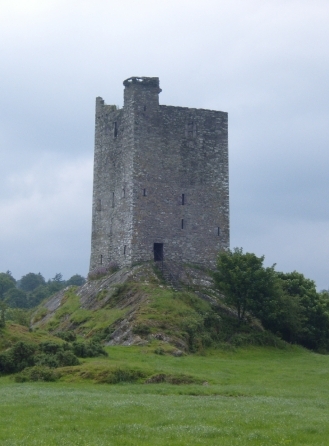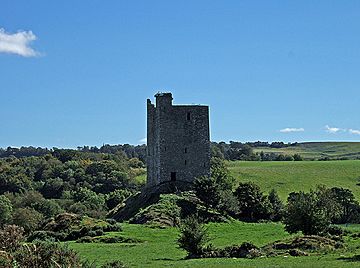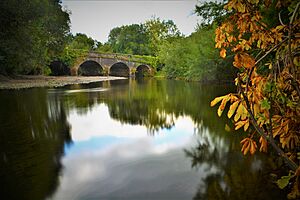Carrigaphooca Castle facts for kids
Carrigaphooca Castle (which means 'Castle on the Rock of the Fairy' in Irish) is an old, ruined stone tower. It has five floors and sits on a tall, rocky hill. This hill looks over the Sullane River in County Cork, Ireland. The castle is about 6 kilometers west of a town called Macroom. It was built a long time ago, around 1336 to 1351, by Donal MacCarthy. He was part of the powerful MacCarthy family. The castle is made from sandstone and limestone. It was built to protect the area.
Carrigaphooca is in an area with many ancient monuments, like a stone circle nearby. The castle is on private land, so you can't visit it anymore. However, the Irish government owns it and keeps it in good condition.
Contents
History of Carrigaphooca Castle
Carrigaphooca was built as a strong defensive tower, not a fancy castle with many rooms. It was likely built between 1436 and 1451 by Donal MacCarthy. His family, the MacCarthys of Muskerry, were a very important family in medieval Ireland. They had lost some of their land in the 1200s and were trying to get it back when the tower was built.
Why was Carrigaphooca Castle important?
The castle was built in a very important spot. It was on the main road between Macroom and County Kerry. This made it a key place to control the area. The MacCarthy family often fought with other families. Because of this, the tower was attacked many times.
What happened during the Siege of Kinsale?
In 1601, a man named Cormac Teige McCarthy, who was the Lord of Blarney Castle, hid in Carrigaphooca. He had supported the Irish side during a big battle called the Siege of Kinsale. He stayed safe in the tower until Queen Elizabeth I forgave him. He wrote her a personal letter to say he was sorry.
The 1602 attack on the castle
In 1602, the castle was attacked again. Donal Cam O'Sullivan Beare and another MacCarthy family member led the attack. After a long siege, their soldiers broke through the outer wall. They then burned the wooden door at the entrance. The people defending the castle gave up and were allowed to leave safely.
Exploring Carrigaphooca Castle
This five-story tower has a simple design. It sits on a very high, jagged rock. This made it very hard for attackers to reach.
Inside the tower
The ground floor room has small windows that let in some light. A straight stone staircase with 11 steps leads to the first floor. From the second to the fourth floor, the stairs become spiral. In total, there are 54 steps in the stairwell. Most towers from this time had dark ground floors. But Carrigaphooca's ground floor has three windows. These windows are set deep into the walls, showing how thick they are. Birds, especially crows, often fly into these narrow windows. They have dropped many twigs inside since the tower became a ruin.
The castle's design is quite simple. There is one window left on the eastern side, across from the entrance to the second floor. Like the other windows, it has a basic stone top called a lintel. Carrigaphooca does not have a fireplace. This suggests it was built more for protection than for comfort. One writer said it "must have offered considerable security to the besieged."
The very top floor might have had living areas and perhaps a fireplace. The windows on the north and south walls are much bigger than on other floors. They offer amazing views of the valley around the castle. You can even see distant mountains like the Killarney Paps and Mullaghanish.
Defenses of the castle
The tower once had two outer defensive walls, but these are now gone. You can still see parts of two corner bartizans. These were like small stone boxes sticking out from the top corners of the walls. Defenders could stand inside them and shoot down at attackers. The first floor was likely a single room used by the guards. The wooden floor was held up by carved stone supports called corbels, which you can still see.
Restoration work
In the 1970s, the Office of Public Works repaired parts of the castle. They added steps over the rock base to reach the main entrance. They also added a narrow, stepped turret (a small tower) to get to the walkway around the roof. However, this was later blocked off in the 1980s for safety reasons.




